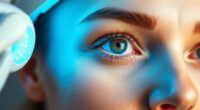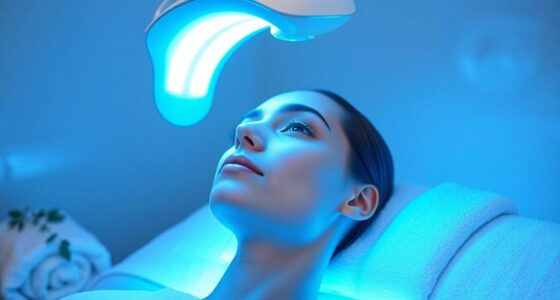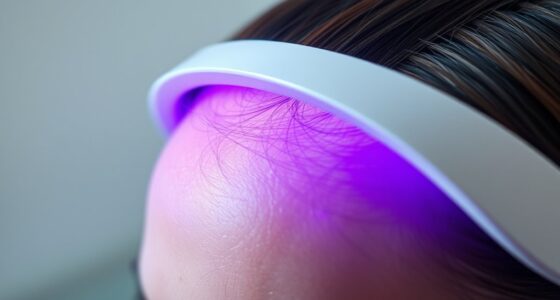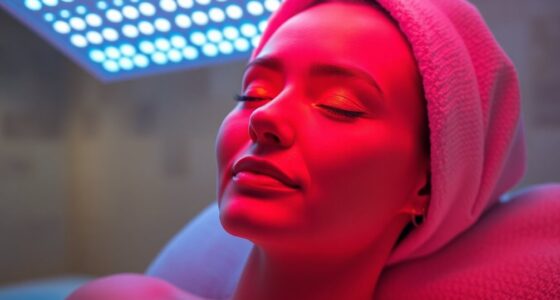Green light therapy shows promise as a non-invasive way to reduce migraine frequency and severity, though it’s not yet universally proven. Research indicates that specific wavelengths of green light may calm hyperactive neural responses linked to migraines, offering an alternative to medication. While some users report fewer migraines and greater relaxation, studies are still ongoing to confirm its effectiveness. To discover whether green light could fit into your migraine management, keep exploring the latest findings.
Key Takeaways
- Green light therapy shows promising potential to reduce migraine frequency, but is not yet universally accepted as a proven treatment.
- Current research supports its neural calming effects, though definitive evidence of widespread efficacy is still pending.
- It is considered a complementary approach, often used alongside traditional medications, with individual responses varying.
- Safety profiles are favorable, but optimal usage protocols are still under scientific investigation.
- More rigorous studies are needed to establish green light therapy as a medically proven, standard migraine treatment.
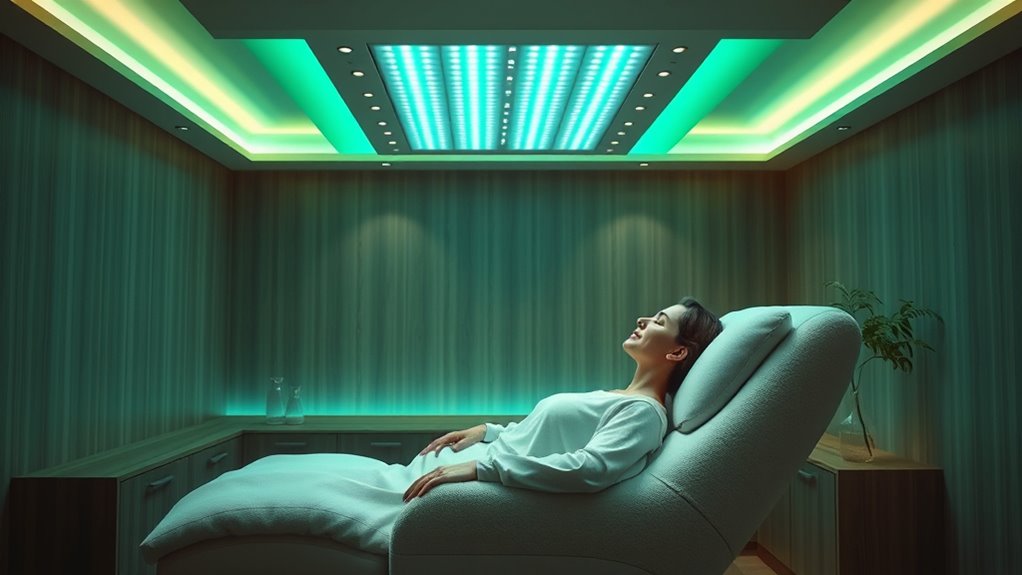
If you suffer from migraines, you’ve probably tried various remedies to find relief. One emerging approach gaining attention is the use of green light therapy. Unlike traditional medications, green light offers a non-invasive option that may influence your neural response to pain. The idea behind light therapy is to expose your eyes to specific wavelengths of light, which can modulate how your brain processes pain signals associated with migraines. Some research suggests that certain light colors, including green, can reduce migraine frequency and intensity by calming hyperactive neural responses that trigger or worsen attacks.
Green light therapy may reduce migraines by calming hyperactive neural responses.
When it comes to light therapy, green light is believed to affect your neural response differently than other colors. Studies indicate that exposure to green light can lead to a calming effect on the brain, potentially decreasing the hyperexcitability that often underlies migraine episodes. This process involves complex neural pathways, where light signals are transmitted from your eyes to your brain’s visual cortex and other pain-processing regions. By targeting specific wavelengths like green, you may influence this neural response, helping to prevent or lessen the severity of migraines. This approach is appealing because it targets the root of neural hyperactivity, rather than just masking symptoms with medication.
While the concept of green light therapy is promising, it’s important to understand that research is still ongoing. Some clinical trials have shown encouraging results, suggesting that consistent exposure to green light can considerably reduce migraine frequency in certain individuals. However, not everyone responds the same way, and the best duration and intensity of light exposure are still being studied. It’s vital to approach green light therapy as a potential complementary treatment rather than a guaranteed cure. Consult your healthcare provider before starting any new light-based treatment, especially if you have underlying eye conditions or sensitivities.
Implementing green light therapy typically involves using specialized light glasses or devices designed to emit the specific wavelength. These are often used for a set period each day, providing a controlled environment to influence your neural response. Many users report feeling more relaxed and experiencing fewer migraines after consistent use. The safety profile appears favorable, especially compared to some medications with more notable side effects. Still, it’s essential to monitor your response and discuss your progress with a medical professional. While green light therapy isn’t yet universally accepted as a standard treatment, it’s a promising avenue that warrants further research and personalized application. Additionally, understanding the effectiveness and safety of such treatments is crucial for making informed decisions about migraine management.
Frequently Asked Questions
Can Green Light Therapy Replace Medication for Migraines?
You wonder if green light therapy can replace medication for migraines. While it may help reduce light sensitivity and visual discomfort, it’s unlikely to fully replace medications, especially for severe migraines. Green light could serve as a complementary approach, easing symptoms for some. However, you should consult your healthcare provider to determine the best treatment plan, as individual responses vary and medications still play a vital role in migraine management.
Are There Any Age Restrictions for Green Light Migraine Treatment?
You might wonder about age restrictions for green light migraine treatment, and research shows there are some pediatric considerations. While generally safe for adults, children and teenagers should consult healthcare providers first, as age restrictions can vary based on individual health and development. It is crucial to verify that this therapy is appropriate for younger patients before use, so medical guidance helps tailor treatment plans safely for all ages.
How Quickly Can One Expect Relief Using Green Light Therapy?
You might notice relief from green light therapy within a few sessions, though it varies based on light intensity and session duration. Typically, you can expect some improvement after 2-3 weeks of consistent treatment. Adjustments in light intensity and session length may speed up results. Keep track of your symptoms and communicate with your healthcare provider to optimize your treatment plan for quicker relief.
Are There Potential Side Effects From Prolonged Green Light Exposure?
Did you know that prolonged green light exposure can lead to photosensitivity concerns? You might experience eye strain or discomfort if you use green light therapy excessively. While generally safe, extended exposure could worsen these issues or cause fatigue. It’s important to monitor your response and limit exposure to prevent potential side effects, ensuring you’re not adding stress to your eyes or overall well-being.
Is Green Light Therapy Effective for All Migraine Types?
You might wonder if green light therapy works for all migraine types. While some people find relief from various migraine types using green light, it doesn’t guarantee effectiveness for everyone. Factors like migraine severity and individual response can influence results. Green light has shown promise, but it’s not a universal cure. You should consult your healthcare provider to see if green light therapy suits your specific migraine type and condition.
Conclusion
So, next time your migraine strikes like a thunderstorm, consider green light as a calming breeze, gently easing the storm within. While the science is still painting its full picture, this soothing hue might just be your secret ally in turning down the volume on your pain. Think of green light as a gentle lighthouse guiding you through the storm, offering hope and relief in a world often clouded by discomfort. Give it a try—you might just find your calm.

